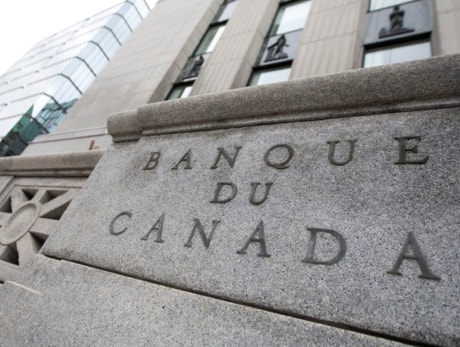OTTAWA — The Bank of Canada is continuing to push up interest rates despite conceding that the recovery is weakening and that an “unusual uncertainty” hovers over the country’s economic future.
The central bank hiked the policy rate a quarter point for the third time in about as many months Wednesday, this time taking the overnight setting to one per cent. It had been as little as 0.25 per cent as recently as June.
Some economists said the bank’s hawkish accompanying statement that downplayed the recent slowdown means more hikes are in the offing this fall unless the economy suffers a further setback.
That appears to have been the market interpretation. The Canadian dollar jumped more than a cent on the news and was trading above 96 cents US for most of the day.
The policy rate will have the immediate effect of raising short-term lending costs, such as variable mortgages and lines of credit.
Most of the major lenders announced they would hike their prime rate a quarter point to three per cent, effective Thursday.
But economists, and the bank itself, noted that the increases have yet to be passed on to longer-term rates, such as fixed mortgages, which are tied to the resurgent bond market.
“As a result of monetary policy measures taken since April, financial conditions in Canada have tightened modesty but remain exceptionally stimulative,” the bank said.
Even at one per cent, the policy rate is below inflation and well south of the three to four per cent range most consider a normal overnight setting.
Economists say the hikes have had minimal impact on the real economy so far, although the loonie’s surge suggests the bank’s actions have not been totally without consequence.
In an explanation, the bank’s governing council blamed U.S. economic weakness — not its slow withdrawal of monetary stimulus — for the sharper-than-expected slowdown in the pace of growth in Canada.
In fact, the bank’s governing council downplays last week’s second-quarter finding that growth slowed to two per cent, after a 5.8 per cent advance in the first three months of the year. The Bank of Canada had expected a three per cent increase in output as late as July.
“Economic activity in Canada was slightly softer in the second quarter than the bank had expected, although consumption and investment have evolved largely as anticipated,” the council wrote.
“Going forward, consumption growth is expected to remain solid and business investment to rise strongly.”
Economists at IHS Global Insight, who have generally been critical of central banker Mark Carney for moving ahead of his G7 peers in tightening monetary policy, agree the latest hike is unlikely to impact the economy.
But that’s because the “global bond markets are driving long-term rates lower and generating easier credit conditions — essentially doing the bank’s job for it in a vicarious twist of fate,” they say.
Still, Bank of Montreal economist Douglas Porter believes Carney is taking some risk given the recent weakness in economic indicators.
After strong gains, employment slid in July. Meanwhile, Canada’s red hot housing market has turned cooler, although an analysis Wednesday by the Conference Board predicted there will not be a free-fall in housing in Canada as happened south of the border.
Porter said continued tightening could dampen borrowing, further slowing down house sales and construction. Meanwhile, a stronger dollar depresses exports and encourages imports to the detriment of local suppliers.
“I don’t see it as a big risk yet, however,” said Porter. “I think it would take a substantial downward surprise for the bank not to raise further in October.”
On that point, economists are divided. TD Bank chief economist Craig Alexander says he sees Carney in a strictly “reactive mode,” and predicts he will proceed on the tightening track only if the economic indicators improve.
One key signal of where the economy is headed will come Friday when Statistics Canada releases the employment data for August.
Alexander said he believes Carney may want to raise rates but will be forced back to the sidelines by deteriorating economic conditions.
He notes that Carney’s forecasts for growth in 2011 have been tracking down, from 3.5 per cent in January, to 3.1 per cent in April to the current projection of 2.9 per cent in the governor’s report delivered in July.
“I think the economy is going to grow at about two per cent in 2011, and not the 2.9 per cent the bank forecast in July,” he said.
The Bank of Canada appears to be reluctant to abandon what many consider an optimistic view on the recovery, however. In its statement, the bank concedes that growth has been lower than expected and will be more muted going forward, but uses the modifier “slightly” to characterize the extent of the change.
But analysts question how much further Carney can go with the United States, Canada’s largest trading partner, contemplating more stimulus. The gap between the U.S. and Canadian policy setting is now a full percentage point.
“Any time we’ve been more than two percentage points above the U.S., it’s spelled trouble,” said Avery Shenfeld, chief economist with CIBC World Markets.
